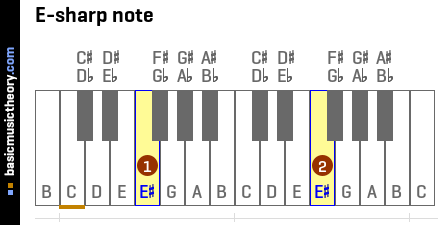E Sharp?
- KVRAF
- 10683 posts since 20 Nov, 2003 from Lost and Spaced
- KVRAF
- 7921 posts since 12 Feb, 2006 from Helsinki, Finland
Notes like E# happen all the time in classical and it's not even limited to single flats or sharps. There are plenty of classical pieces where some notes might have double flats (bb) and in fact for double sharps there is even special notation (x is used instead of ##; no idea why double flats are still just notated bb though).
- KVRAF
- 16547 posts since 22 Nov, 2000 from Southern California
Don't let your wife see that search history...
- KVRAF
- 5564 posts since 2 Sep, 2019
Google lies.
E♯ isn't the same as F♮ any more than A♯ is the same as B♭.
They're not even the same frequency in Pythagorean tuning.
...also, those F's aren't natural.
E♯ isn't the same as F♮ any more than A♯ is the same as B♭.
They're not even the same frequency in Pythagorean tuning.
...also, those F's aren't natural.
THIS MUSIC HAS BEEN MIXED TO BE PLAYED LOUD SO TURN IT UP
-
- KVRAF
- 2374 posts since 17 Apr, 2004
Voted KVR's resident drunk Robert Smith impersonator (thanks Frantz!)
https://open.spotify.com/artist/2myYesRBRgQB3LkZzEYdt5 | https://soundcloud.com/steevm/
https://open.spotify.com/artist/2myYesRBRgQB3LkZzEYdt5 | https://soundcloud.com/steevm/
- KVRAF
- 7921 posts since 12 Feb, 2006 from Helsinki, Finland
There is actually a somewhat recent study (https://www.nature.com/articles/s41467-024-45812-z) suggesting that slightly imperfect ratios are preferable to pure Pythagorean tuning.
-
- addled muppet weed
- 106128 posts since 26 Jan, 2003 from through the looking glass
-
- KVRAF
- 2374 posts since 17 Apr, 2004
One key to the right of E. That's how you sharpen a note - you move 1 to the right.
Move to the left and it's a flat. Try this with F or C and blow your mind
So E# is the same key as G double flat.
Last edited by sjm on Mon May 06, 2024 5:49 pm, edited 1 time in total.
Voted KVR's resident drunk Robert Smith impersonator (thanks Frantz!)
https://open.spotify.com/artist/2myYesRBRgQB3LkZzEYdt5 | https://soundcloud.com/steevm/
https://open.spotify.com/artist/2myYesRBRgQB3LkZzEYdt5 | https://soundcloud.com/steevm/
- KVRAF
- 10683 posts since 20 Nov, 2003 from Lost and Spaced

It's right there, it's the left side of the F key. the LEFT side.
Last edited by osiris on Mon May 06, 2024 5:50 pm, edited 1 time in total.
- KVRAF
- 10348 posts since 7 Sep, 2006 from Roseville, CA
It's the white key to the left of the F## key.
Logic Pro | PolyBrute | MatrixBrute | MiniFreak | Prophet 6 | Trigon 6 | OB-6 | Rev2 | Pro 3 | SE-1X | Polar TI2 | Blofeld | RYTMmk2 | Digitone | Syntakt | Digitakt | Integra-7 | TR-8S | MPC One | TD-3 MO
-
- addled muppet weed
- 106128 posts since 26 Jan, 2003 from through the looking glass
- KVRAF
- 5564 posts since 2 Sep, 2019
That depends. Is it a well-tempered clavier, or meantone?
You could argue that none of the notes are really on a piano keyboard, except for C.
And even C hasn't actually been C since 1936.
THIS MUSIC HAS BEEN MIXED TO BE PLAYED LOUD SO TURN IT UP
- KVRAF
- 10683 posts since 20 Nov, 2003 from Lost and Spaced
It's just a jump to the left....
- KVRAF
- 16547 posts since 22 Nov, 2000 from Southern California
And then a step to the right…
- KVRAF
- 10683 posts since 20 Nov, 2003 from Lost and Spaced


